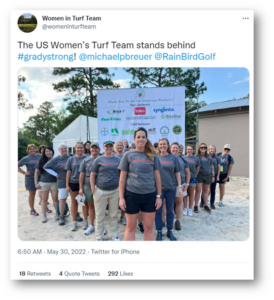 This year USGA’s 77th U.S. Women’s Open (USWO) Championship was held June 2-5, hosted by Pine Needles Lodge & Golf Club in Southern Pines, North Carolina. The USWO is the most prestigious event in women’s golf, and this year the biggest purse in women’s history was offered at $10 million.
This year USGA’s 77th U.S. Women’s Open (USWO) Championship was held June 2-5, hosted by Pine Needles Lodge & Golf Club in Southern Pines, North Carolina. The USWO is the most prestigious event in women’s golf, and this year the biggest purse in women’s history was offered at $10 million.
Volunteering on the grounds crew at a major is something that is a highly desirable experience for a turfgrass professional. It is a good resume-builder and educational experience and provides a unique opportunity to meet other industry professionals. Traditionally, maintenance volunteers are local to the area. Since the golf industry is heavily male dominated (only 2% of Golf Course Superintendents Association members are women) women volunteers are hard to find.
After the tremendous success at The Olympic Club last year, Rain Bird partnered with Syngenta for a 2nd year to get more women volunteers at the USWO. Ultimately, 27 women volunteered on the grounds crew at Pine Needles. Working with David Fruchte, Director of Golf Course Grounds, Rain Bird arranged the flights for the women volunteers traveling as far away as Washington and Oregon.
Hear from the women breaking the grass ceiling.
Last year Kayla Kipp and Jill Seymour shared their experience volunteering at the 2021 USWO at The Olympic Club (2021 USWO Article). See what they say about their second experience volunteering as the OGs of the group.
 Kayla Kipp was formally working as the Golf Course Equipment Maintenance Manager at Lodestone Golf Course & Fantasy Valley Golf Course. While she enjoyed where she worked, the late-night winter shifts impacted her motivation to work, so she decided to take the winter off. With encouragement and tips from the Women in Turf, GCSAA, and the women she met last year, she was able to interview with the Director of Golf at Nemacolin, Chris Anderson. Nemacolin has 2 Pete Dye designed courses, one of them being Mystic Rock, where the 84 Lumber Classic was played in the early 2000s. Kipp knew she was looking for championship golf and this was her opportunity. She has been the Equipment Manager there for the last 3 months and has already obtained her Level 1 and Level 2 Equipment Manager certificates and plans on tackling the certification in the fall.
Kayla Kipp was formally working as the Golf Course Equipment Maintenance Manager at Lodestone Golf Course & Fantasy Valley Golf Course. While she enjoyed where she worked, the late-night winter shifts impacted her motivation to work, so she decided to take the winter off. With encouragement and tips from the Women in Turf, GCSAA, and the women she met last year, she was able to interview with the Director of Golf at Nemacolin, Chris Anderson. Nemacolin has 2 Pete Dye designed courses, one of them being Mystic Rock, where the 84 Lumber Classic was played in the early 2000s. Kipp knew she was looking for championship golf and this was her opportunity. She has been the Equipment Manager there for the last 3 months and has already obtained her Level 1 and Level 2 Equipment Manager certificates and plans on tackling the certification in the fall.
Difference between The Olympic Club and Pine Needles: “The maintenance facility was much smaller at Pine Needles, so having a lot of people in the shop all at once wasn’t helpful. I spend most of my days behind a grinder, so when I got to opportunity to become a roving technician/beverage cart attendant, it was a blessing for me. This gave me the awesome opportunity to go out and take pictures of my fellow women in turf, while they worked, and had fun singing, dancing and smiling. I was able to connect with the ladies more than I was able to at Olympic Club. At Olympic Club, I learned pivotal information in my reel grinding that has really taken me to where I am now thanks to Todd Blankenship (Bernhard Grinders). Between the two, I can’t choose a favorite because each had its perfect orientation for me at that time. Another cool difference this year, was that the women call me Miss Fix-It and no matter if it was making a go-pro tool, sharpening cup cutters, etching mugs or making tools for our cup changing crew, they knew who to call. Getting out of the daily grind is so refreshing and invigorating. As a crew, we are closer, stronger, gelling.”
Favorite Takeaways: “When I separated from the Air Force in 2012, I lost a very large family. When I became a GCSAA member in 2018, I started to see an entire world of likeminded individuals. Olympic showed me a potential family that I had been missing. When I got the chance to be on the course with the women, it was apparent, that this is my Turf Family. I don’t think there is any limit on what we would do for each other. That’s my favorite takeaway, realizing this is my family. On the side, the largest purse for the women’s open, more spectators, more females on the volunteer crew, just more! It’s growing and that is what we were hoping for.”
Work Life Balance in the Golf Industry: “Before taking the winter off, I had lost all recognition of work life balance. It was killing my spirit, my drive, and my willingness to be involved. Taking time to care for yourself is so undervalued in some circles. In turf, we care so much about what we are caring for that oftentimes we put our personal needs to the side. Take time off to be with family, travel, treat yourself. If you’re ever in a funk, step back and reevaluate what you’re looking for. It was the greatest thing I’ve done in my 34 years so far.”
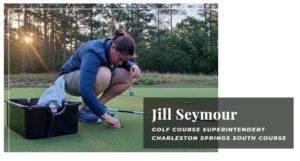 Jill Seymour has been working in the golf industry for the last 20 years. She is currently the Golf Course Superintendent at Charleston Springs South Course. Seymour loves volunteering and learning new and different ways of doing things alongside other amazing people doing what they all love. Getting 30 women volunteers was unheard of…until now. This is her second time volunteering at the USWO and notes how the camaraderie between the women is unmatched compared to other events.
Jill Seymour has been working in the golf industry for the last 20 years. She is currently the Golf Course Superintendent at Charleston Springs South Course. Seymour loves volunteering and learning new and different ways of doing things alongside other amazing people doing what they all love. Getting 30 women volunteers was unheard of…until now. This is her second time volunteering at the USWO and notes how the camaraderie between the women is unmatched compared to other events.
Difference between The Olympic Club and Pine Needles: “Last year at Olympic was monumental. It was historic in the fact that nothing like that had been done before…. bringing on a crew of 30 women volunteers to assist the maintenance crew in preparing the golf course for the tournament. This year at Pine Needles we were really able to showcase what we are capable of. With David having such a small crew…I feel we were instrumental in helping them dial everything in for the week of the tournament. We arrived on site Sunday, given our assignments that night, Monday morning we were out working alongside David’s crew without skipping a beat! The biggest challenge was probably learning to navigate the course quickly.”
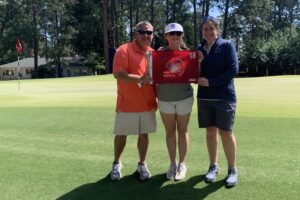
Favorite Takeaways: “On Saturday, while I was cutting the pin on #17, there was a 15-year-old girl watching me. As I walked off the green, I had the pleasure of meeting Kelce and her father when she asked me for my autograph. She is an avid golf fan and is interested in becoming a Golf Superintendent when she grows up…. not far off from her dad who is a Sports Field Manager. I was blown away by the fact that she watched and was interested in the whole process of cutting the cup for the tournament. We invited them to come down to the maintenance tent later that day where the Open Cup would be. Kelce and her parents showed up and we introduced her to the entire crew….as our future…. our reason for #womeninturf!”
Best ways to increase women’s presence in golf: “Presence, visibility, and action! We need to be there…. insert ourselves…don’t wait to be invited. And once we are in….we need to prove just how passionate and capable we are! We need to continue this tradition of working the Women’s US Open. It is arguably the best platform for us to reach young women and girls interested in this as a profession.”
Barriers for women in golf: “I think one of the biggest barriers for women in golf or any profession can be ourselves. We are too often intimidated or afraid to insert ourselves and speak up. But together, as a united front, we cannot be ignored, dismissed, or hushed. That is why this dynamic group is so important. I believe it holds more weight than even we are aware. The potential of this group is massive!”
While Jennifer Torres and Tonya Anderson might have been part of the “New Gs” of the the group, they have a combined 29 years of experience in the golf industry.
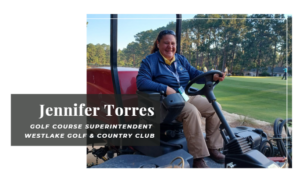 Jennifer Torres has been working the golf industry for 19 years, and she is currently the Golf Course Superintendent at Westlake Golf & Country Club. Working on a course with a smaller staff, she finds herself wearing many, many hats. Her volunteer task for the week was mowing the back nine fairways in the morning and repairing divots in the evening, what she considered a nice break from her everyday course life.
Jennifer Torres has been working the golf industry for 19 years, and she is currently the Golf Course Superintendent at Westlake Golf & Country Club. Working on a course with a smaller staff, she finds herself wearing many, many hats. Her volunteer task for the week was mowing the back nine fairways in the morning and repairing divots in the evening, what she considered a nice break from her everyday course life.
Favorite Experience: “Being surrounded by brave, strong women that are determined to make a difference by sharing their passion and lifting everyone in process. The energy these women brought to David and his staff after the tragic accident their mechanic was in, was like a jolt of epi to a person having a heart attack. They are powerful in numbers.”
Challenges In Her Professional Career: “I knew I needed to be a mom first in my career, so I was limited to courses that allowed me the ability to do both. Now as I meet more people, I am thinking that may not actually have been true, many of the bigger operations do have a work life balance I never thought had.”
Bringing More Women into the Industry: “By being visible and having seats at the tables, we can help grow the industry in a positive way. The time is now, not “someday, today”! We need to educate women and people from all diverse backgrounds that there is a place in this industry for everyone. You just have to find the right fit. Make priorities to keep the balance, although I struggle at this myself, we need to know the grass will be there tomorrow sometimes we just have to go home. The biggest way others can support woman is realizing we are in the room; we have a place and can fill many of the needs every superintendent has. Secondly, encourage participation at the highest level now, not some day in the future.”
Tonya Anderson, Golf Course Superintendent at Old Memorial Golf Course, shares her first-time experience volunteering at the USWO.
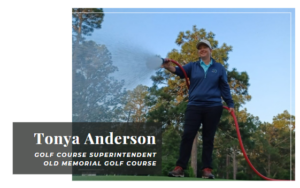
“My time volunteering for the U.S. Women’s Open was incredible. It blew my expectations out of the water. I assumed heading into the experience I would work a lot of hours, undoubtedly meet new people, and be exhausted by the end of the week. All of that was true but to a whole different degree. I met 30 other women in the industry who I now consider friends, colleagues, and peers in the highest regard. I did in fact work a lot of hours, all with a smile and positive attitude. Working all those hours seemed like minutes when your team is comprised of hard-working individuals who take such great pride and responsibility in their jobs. I never felt like I was alone or got the impression anyone didn’t want to be there, our team’s energy and ability to lift each other up will go unrivaled in my book. And lastly, by the end of the week yes, we were running on fumes, but I guarantee we all would have stuck it out another day or even week if that meant we got to spend more time with each other. I believe that last sentence speaks for itself.”
Thoughts on getting more women in the golf industry: “I would love to see more women in the industry. There is no good reason there shouldn’t be more women involved. The best thing that can happen is for more people (men) to take a chance on us. Consider us in your hiring process, consider us when it comes to solving staffing problems, consider us when you’re tired of the same old unskilled labor force you continue to struggle with year in and year out. We’re putting ourselves out there and we just ask for the same thing in return. You won’t be disappointed.”
Tonya has been in the golf industry for ten years, she was recently featured by her local news station, watch the video here.
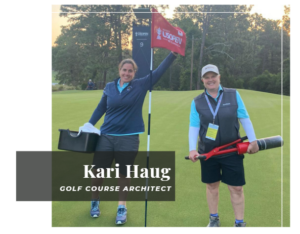 Kari Haug, Golf Course Architect, worked with Jill Seymour cutting cups this year. As an architect she is usually looking at the course from a strategic and playability perspective, she got to shift gears and look at it from an agronomic perspective during preparation for a Championship tournament, which was a big change from her normal day to day job.
Kari Haug, Golf Course Architect, worked with Jill Seymour cutting cups this year. As an architect she is usually looking at the course from a strategic and playability perspective, she got to shift gears and look at it from an agronomic perspective during preparation for a Championship tournament, which was a big change from her normal day to day job.
Differences between this year and last year: “This year allowed for a much more hands-on approach with more meaningful work, and it was a better learning experience for me. I was glad to have more interaction with the USGA Green Section staff, GCSAA, Superintendents from across the US, Industry Partners, and USGA Championship Tournament Director Shannon Rouillard. I am very thankful for the opportunities we had to meet and spend time with people from all different sectors of the golf industry!”
How do we increase women presence in the golf industry? “We can increase the presence of women in the golf/turf industry by hosting more inclusive events, like the Women In Turf Team at the US Women’s Open is part of the answer. It is very important to recognize that corporate support is essential! – So thank you Syngenta, Rain Bird, and all the others for providing that support. Continuing to highlight the #seeitbeit campaign, expanding mixed men’s/women’s events, providing a corporate platform for women to network, and many more ways that we haven’t even thought of yet will be essential to recruitment and retention of women in the industry. Ongoing and sustained discussion about the barriers and development of solutions to lower/remove the barriers is critical – don’t let up! Hopefully the Women in Turf Team can expand and find new avenues to exist and continue to get stronger in the future. I think concentration of the effort with women as the focus rather than diluting and diversifying the effort is the answer.”

